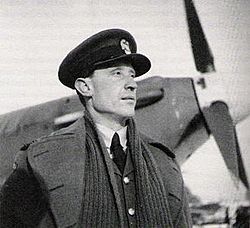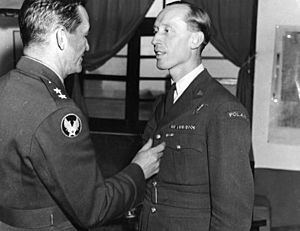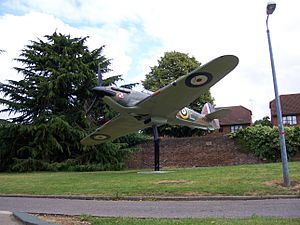Witold Urbanowicz facts for kids
Quick facts for kids
Witold Urbanowicz
|
|
|---|---|

Witold Urbanowicz
|
|
| Birth name | Witold Aleksander Urbanowicz |
| Born | 30 March 1908 Olszanka, Augustów County, Poland, Russian Empire |
| Died | 17 August 1996 (aged 88) New York City, New York, U.S. |
| Allegiance | |
| Service/ |
|
| Years of service | 1930–1946 |
| Rank | Air Vice Marshal |
| Service number | 781951 |
| Battles/wars | World War II |
| Awards |
|
| Other work | Commercial pilot (1946–1973) |
Witold Urbanowicz (born March 30, 1908 – died August 17, 1996) was a brave Polish fighter ace during World War II. He was one of the best Polish pilots, known for shooting down many enemy planes. He officially shot down 17 enemy aircraft, making him the second highest-scoring Polish ace. Witold Urbanowicz received important awards like the Virtuti Militari and the British Distinguished Flying Cross for his courage. He also wrote books about his experiences.
Contents
About Witold Urbanowicz
Witold Urbanowicz was born in a place called Olszanka, Augustów County. When he was 22, in 1930, he joined a special flying school for future pilots in Dęblin. He finished his training in 1932 and first worked as an observer in a bomber squadron in Warsaw. Later, he trained to become a fighter pilot. In the 1930s, he flew with famous Polish squadrons, including the 113th and the No. 111th "Kościuszko" Squadron.
In August 1936, while flying a PZL P.11a plane, he shot down a Soviet reconnaissance plane. This enemy plane had flown into Polish airspace. He was officially told off for this, but his boss secretly congratulated him. As a "punishment," he was moved to a training school in Dęblin in October 1936. There, he earned the nickname "Cobra" because of his sharp flying skills.
World War II and the Battle of Britain
When Germany invaded Poland in 1939, Witold Urbanowicz was part of a group of flying instructors. They flew older PZL P.7a fighter planes. Their job was to protect the airfields at Dęblin and Ułęż. Even though they met enemy planes, their slower Polish fighters could not shoot down any German bombers. On September 8, the school had to leave Ułęż and Dęblin.
Witold was told to go to Romania with the young cadets. They hoped to get new planes from Britain and France, but no aircraft arrived. Urbanowicz decided to go back to Poland to keep fighting. However, after the Soviet Union invaded Poland in 1939, he was captured by a Soviet group. The same day, he managed to escape with two cadets. They crossed into Romania and eventually made their way to France. A new Polish army was forming there after Poland's fall.
While in France, Witold and other Polish pilots were invited to join the Royal Air Force (RAF) in Great Britain. After some initial training, he learned to fly fighter planes in July 1940. In August, he joined No. 145 Squadron RAF. On August 4, 1940, he was ready for combat. On August 8, he shot down a Messerschmitt Bf 110 enemy plane. Four days later, on August 12, he shot down a Junkers Ju 88.
On August 21, he moved to the famous Polish-manned No. 303 Squadron. He flew a Hawker Hurricane and became a flight commander. On September 6, he shot down another enemy plane, a Bf 109. On September 7, he became the Squadron Leader after the previous leader was badly hurt. On September 15, Urbanowicz claimed two more enemy planes, both Dornier Do. 17s.
On September 18, 1940, Witold Urbanowicz received the Silver Cross of the Virtuti Militari. This was a very important Polish military award. The Commander-in-Chief of the Polish Forces, General Władysław Sikorski, gave him the award. On October 24, he also received the British Distinguished Flying Cross.
On September 27, he was officially credited with shooting down four aircraft. These included two Ju 88s, a Bf 109, and a Bf 110. On September 30, he claimed three more Bf 109s and one Dornier Do 17. Even with all his success, Urbanowicz was not always popular with Polish leaders. On October 21, he had to give up command of the squadron.
During the Battle of Britain, he officially shot down 15 enemy planes and likely one more. This made him one of the top Polish aces. He was second only to Stanisław Skalski and among the top ten Allied aces in that battle.
From April 15 to June 1, 1941, he led the 1st Polish Fighter Wing at RAF Northolt. After that, he worked in a staff role at No. 11 Group RAF HQ. In June 1941, he became the second Air Attaché (a military diplomat) at the Polish Embassy in the United States.

In September 1943, Urbanowicz joined the USAAF 14th Air Force in China. On October 23, he joined the 75th Fighter Squadron of the 23rd Fighter Group, also known as the "Flying Tigers". He flew a P-40 Warhawk plane and took part in several combat missions. On December 11, he fought against six Japanese planes and claimed to have shot down two. These were actually Nakajima Ki-44 "Tojo" fighters.
He reported shooting down other planes and destroying some on the ground in China. However, these victories were not officially confirmed. According to one historian, he shot down 11 Japanese aircraft while visiting Claire Lee Chennault. He later received the US Air Medal and a Chinese Flying Cross for his service.
In December 1943, he returned to the United Kingdom. Later, he became an Air Attaché in the USA again.
Life After the War
In 1946, Witold Urbanowicz went back to Poland. However, the new communist Służba Bezpieczeństwa secret police arrested him four times. They thought he might be a spy. After he was released, he moved to the USA. He lived in New York City and worked for several airlines, including American Airlines and Eastern Airlines. He retired in 1973.
In 1991, after communism ended in Poland, he visited his home country. He visited again in 1995 and was promoted to the rank of General. Witold Urbanowicz passed away in New York on August 17, 1996.
In September 2010, a model of a Hawker Hurricane plane was placed at RAF Uxbridge. It is painted in the colors of Urbanowicz's plane from the Battle of Britain. This model is a special display called a "gate guardian."
Awards and Honors
 Virtuti Militari, Silver Cross (September 18, 1940)
Virtuti Militari, Silver Cross (September 18, 1940)Cross of Valour, four times
 Distinguished Flying Cross (United Kingdom)
Distinguished Flying Cross (United Kingdom) Air Medal (United States)
Air Medal (United States)- Star Medal with Two Stars (Republic of China)


